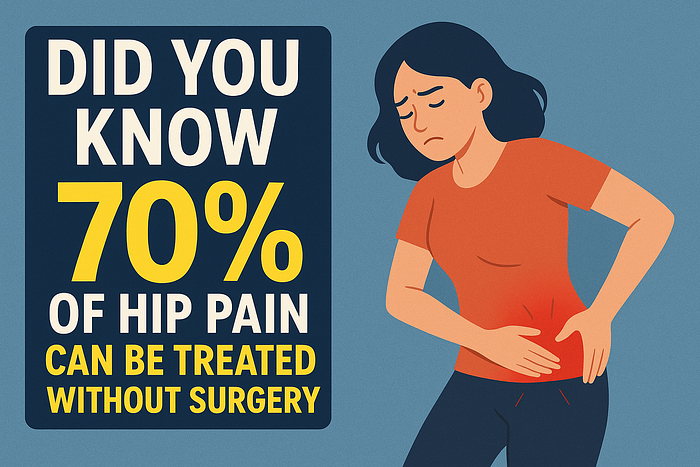Did you know 70% of hip pain can be treated without surgery? Discover effective non-invasive treatment & expert care available in India.
The moment you experience persistent hip pain, thoughts of surgery might flood your mind. However, recent medical advances reveal a surprising truth that brings hope to millions of Indians suffering from hip discomfort. Research consistently shows that approximately 70% of hip pain cases respond excellently to non-surgical interventions, allowing patients to reclaim active lifestyles without going under the knife.

Breaking the Surgery Myth
For decades, surgery seemed like the inevitable destination for anyone experiencing chronic hip pain. This outdated perception has caused unnecessary anxiety among countless patients who assume operative procedures represent their only path to relief.
Modern medicine paints a dramatically different picture. Comprehensive studies tracking thousands of hip pain patients demonstrate that conservative treatment approaches deliver meaningful, lasting results for the overwhelming majority. Understanding various hip pain causes allows healthcare providers to design targeted intervention strategies that address root problems rather than simply masking symptoms.
Why Non-Surgical Approaches Work So Effectively
The success of hip pain treatment without surgery stems from addressing the fundamental mechanisms driving discomfort. Unlike surgical solutions that focus on structural repair or replacement, conservative methods work with your body’s natural healing capacity.
Inflammation Management Forms the Foundation
Many hip pain causes involve inflammatory processes damaging joint tissues. Anti-inflammatory medications, both oral and topical, reduce swelling that compresses nerves and restricts movement. When combined with dietary modifications emphasizing anti-inflammatory foods common in Indian cuisine like turmeric, ginger, and green leafy vegetables, patients experience significant symptom reduction.
Physical Therapy Rebuilds Strength and Flexibility
Targeted exercises supervised by qualified physiotherapists form the backbone of successful hip pain treatment. These programs strengthen muscles supporting hip joints, improve range of motion, and correct biomechanical imbalances contributing to pain.
Indian patients often benefit tremendously from graduated exercise protocols that respect cultural preferences and lifestyle patterns. Programs incorporating yoga-based movements alongside modern rehabilitation techniques yield particularly impressive outcomes.
The Spectrum of Non-Surgical Treatment Options

Conservative First Line Therapies
Initial hip pain treatment typically begins with the least invasive approaches. Rest modification teaches patients to avoid aggravating activities while maintaining appropriate movement levels. Complete inactivity actually worsens many conditions, so qualified guidance from a hip pain specialist in India proves invaluable.
Weight management plays crucial roles for overweight individuals. Each kilogram of excess body weight multiplies stress on hip joints during walking and standing. Even modest weight reduction through balanced nutrition and appropriate exercise can dramatically decrease pain levels.
Advanced Injection Therapies
When basic measures provide insufficient relief, several injection-based treatments offer remarkable benefits. Corticosteroid injections deliver powerful anti-inflammatory medication directly into affected hip structures, providing weeks or months of reduced discomfort.
Hyaluronic acid injections supplement the natural lubricating fluid within joints, improving movement smoothness and cushioning. This viscosupplementation approach particularly benefits arthritis patients experiencing cartilage breakdown.
Regenerative medicine techniques like platelet-rich plasma therapy harness your body’s own healing factors. These cutting-edge treatments available through leading facilities offering advanced hip pain solutions stimulate tissue repair at cellular levels.
Identifying the Right Candidates for Non-Surgical Treatment
Not every hip condition responds equally well to conservative management. Understanding which patients benefit most from hip pain treatment without surgery helps set realistic expectations and optimize outcomes.
Mild to moderate arthritis patients typically achieve excellent results through comprehensive non-surgical programs. Early intervention prevents progression and delays or eliminates the eventual need for hip pain surgery India procedures.
Bursitis and tendinitis respond particularly well to conservative approaches combining rest, physical therapy, and targeted injections. These soft tissue conditions rarely require surgical intervention when properly managed.
Muscle strains and minor labral tears often heal completely with appropriate rehabilitation. Even moderately sized tears can become asymptomatic through exercises that stabilize joints and optimize movement patterns.
When Surgery Becomes Necessary
While 70% of cases respond to non-surgical treatment, acknowledging when conservative measures have reached their limits remains equally important. Severe arthritis with bone-on-bone contact, large structural tears, or conditions causing progressive joint destruction eventually require consultation with the best hip replacement surgeon in India.
Failed conservative therapy after six months of comprehensive treatment suggests surgical evaluation may be appropriate. However, even patients ultimately requiring operations benefit from pre-surgical rehabilitation that strengthens surrounding muscles and improves post-operative recovery outcomes.
Building Your Non-Surgical Treatment Plan
Success with hip pain treatment without surgery requires partnership between patient and provider. Comprehensive assessment by a qualified hip pain specialist in India determines specific hip pain causes affecting your joints.
Personalized treatment protocols combine multiple therapeutic approaches tailored to your unique condition, lifestyle, and goals. Regular follow-up assessments track progress and allow treatment modifications optimizing results.
Conclusion
The 70% statistic represents more than encouraging numbers. It signifies genuine hope for millions experiencing hip pain who fear surgery represents their only option. Modern hip pain treatment approaches harness your body’s natural healing capacity through strategic, evidence-based interventions.
Whether you’re experiencing early symptoms or battling chronic discomfort, exploring comprehensive non-surgical options with qualified professionals offers the highest probability of successful outcomes. Don’t let fear of surgery prevent you from seeking the evaluation and treatment your hips deserve.

Frequently Asked Questions
How long does non-surgical hip pain treatment take to show results?
Most patients notice initial improvements within four to six weeks of starting comprehensive treatment. However, maximum benefits typically develop over three to six months as muscles strengthen, inflammation resolves, and movement patterns improve. Patience and consistent participation in prescribed therapies remain essential for optimal outcomes.
Can I avoid hip replacement surgery forever with non-surgical treatment?
Many patients successfully manage hip conditions indefinitely through conservative measures. However, progressive conditions like severe arthritis may eventually require surgical intervention despite excellent non-operative management. Early treatment maximizes the duration that non-surgical approaches remain effective and delays or potentially eliminates surgery needs.
What makes physical therapy so effective for hip pain?
Physical therapy addresses multiple factors contributing to hip discomfort. Targeted exercises strengthen muscles supporting joints, improve flexibility, correct movement imbalances, and enhance overall joint stability. These benefits work synergistically to reduce pain, improve function, and prevent future problems through better biomechanics.
Are injection therapies safe for long-term hip pain management?
When administered by qualified specialists, injection therapies offer safe, effective relief. Corticosteroid injections are typically limited to three or four per year to minimize potential side effects. Hyaluronic acid and platelet-rich plasma injections carry minimal risks and can be repeated as needed under medical supervision.
How do I know if my hip pain will respond to non-surgical treatment?
Comprehensive evaluation by a hip pain specialist determines your candidacy for conservative management. Factors including pain severity, underlying causes, joint damage extent, overall health status, and previous treatment responses guide recommendations. Most patients receive clear guidance about expected outcomes and appropriate treatment pathways after thorough assessment.